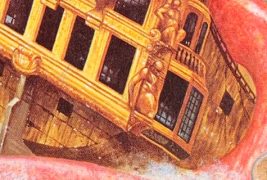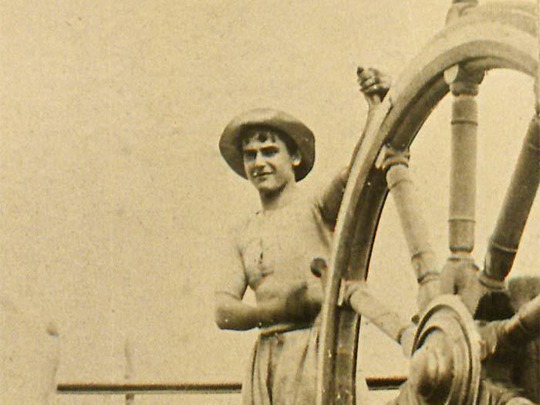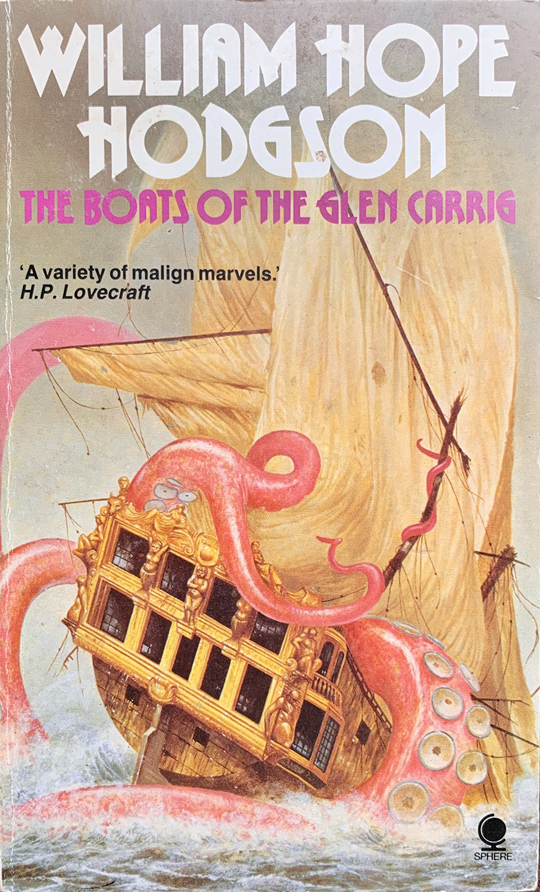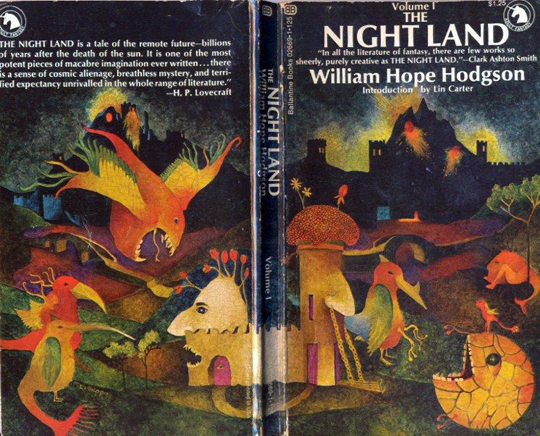
“The sea has never been friendly to man. At most it has been the accomplice of human restlessness.” —Joseph Conrad
The sea has always stirred dark and mysterious thoughts in mankind. It is part of our world, yet it is not our world. We can’t live there as we live upon land. Even in the 21st century, when the world has been explored and catalogued in ways that were unthinkable before, the Deep contains mysteries. And mysteries always lead to stories.
One man who knew how to delve into those mysteries was a writer by the name of William Hope Hodgson. He certainly was not the only man who could tell stories of the sea, but for sure he was one of the most original. He knew how to tap into the universal fears and wonders of the ocean and transmit those feelings to his readers. And because of his own extensive experience sailing on those waters, he knew the practical side of sea life as well.
Hodgson had an interesting and tragically brief life and his restless mind expressed itself in many ways. Although he was a prolific writer, he was never a vastly successful one, at least in terms of money. But he was a huge influence on later writers of the macabre such as H.P. Lovecraft, Abraham Merritt and Clark Ashton Smith. Even modern authors such as China Mieville acknowledged being influenced by his work.
Although Hodgson’s name is not really known to the general public, many horror fans have at least heard it. Since the rise of the internet, his stories and information about him have become much more accessible and in recent years, there has been something of a revival of interest in his works.
Well, I’m looking to do my part! This article will briefly look at his life, which was quite varied and adventurous, and his major works of strange fiction. It has to be said that not all of Hodgson’s writings were in the supernatural or even the fictional mode, but it is his tales of the weird that are most associated with his name.
Hodgson was born in 1877 in rural Essex in England. His father was an Anglican priest, and his family was pretty robust…William was the second of 12 children. He moved frequently in his youth as his father was constantly going from parish to parish. We can infer his childhood was tumultuous, as he tried to run away from home and become a sailor at the ripe age of 13. He was unsuccessful, but his attraction to the sea was manifest at an early age. He finally got his wish in 1891, when he became an apprentice cabin boy. From there, he took up nautical studies, which he excelled at, and finally became a full-fledged sailor.
Much of Hodgson’s writing revolved around the hardships and strangeness of sea-going life. Due to his small stature and handsome looks, he was bullied by older seamen, something he never forgot and hints of which would occasionally pop up in his stories. To make up for this, he became fanatically devoted to what was called “physical culture” back then, but what we would now call body-building and martial arts. It didn’t take long for others to realize young Hodgson could more than take care of himself in a fight. In fact, he later started a school to teach physical culture and many of his non-fiction writings were devoted to the subject. He also became a fine marksman and an excellent photographer. Many of his sea photographs were used in books and newspapers of the time.
The writing of fiction also became an abiding subject for him, and it is for this that he is mostly remembered today. He wrote a fair amount of poetry and straightforward “sea stories” that made use of his extensive nautical knowledge. But he had always had a love for tales of the strange and was a rabid reader of authors like Poe, Wells and Doyle. In 1904, he had his first story “The Goddess of Death” published. It was a modest tale of a Hindu religious statue that came to life to seek vengeance on those who stole it and brought it to England.
That opened the floodgates and there was no turning back. With a special emphasis on sea stories, Hodgson created a whole series of tales that were inspired by the Sargasso Sea, that eerie location where boats were trapped in endless miles of thick seaweed. Nobody could touch on the strangeness of the Sargasso like he could.
The best of these nautical horrors was a novella called “The Boats of the Glen Carrig”. It told the story of 17th century sailors who had to abandon their ship due to a typhoon. In their lifeboats, they are at the mercy of an angry sea and find themselves in a series of weird locales such as an island which is stalked by what seem to be ambulatory, man-eating trees. There is a scene that is a masterpiece of tension in which terrified sailors are quietly staying still in the hold of an abandoned ship while the monsters are searching the upper decks. Later, the Glen Carrig survivors find themselves lost in a Sargasso sea where the descendants of men trapped centuries earlier are inhabitants of the watery limbo. This story was the inspiration for an oddball Hammer film The Lost Continent released in the late ‘60s. In an even stranger situation, the German funeral doom metal band AHAB based an entire album on Hodgson’s story to surprisingly good effect.
Not every story Hodgson wrote was inspired by the sea. He created a character called Carnacki the Ghost Finder who was something of a supernatural sleuth who investigated ghostly incidents. Carnacki’s tales predated later, similar characters like Seabury Quinn’s Jules De Grandin and Joseph Payne Brennan’s Lucius Leffing. You could even say that “The Night Stalker” Carl Kolchak was a distant descendant of Carnacki. Carnacki always tried to use logic and science to solve his mysteries and sometimes discovered that unscrupulous conmen were responsible for the “ghosts” and “monsters.” But just as often, the creatures could be real. A new collection of Carnacki tales for public enjoyment is definitely overdue.
Perhaps the most influential of Hodgson’s stories was “The House on the Borderland”. This bizarre and hallucinogenic tale hugely impressed H.P. Lovecraft and Clark Ashton Smith in their own writings and even modern authors such as Terry Pratchett have acknowledged the power of this surreal tale. First published in 1908, the novel was unlike anything that had been written before, playing games with the reader’s sense of what is real and what isn’t. It tells the story of two men who stumble across a gaping chasm in the seashore and what seems to be ruins next to it. Within the ruins, they find a kind of journal which tells a fantastical tale….
The narrator is a misanthropic old man who lived in a strange round house by the sea with his dog and his sister. He freely admits that local villagers think him mad. One night he has a phantasmagorical vision of a great plain on an alien world. He travels through blackness to this strange world and finds a house that seems to be much like his own, only on a much greater scale. Taking refuge in the house, he soon comes under attack from corpse-white monsters with pig-like features. The story becomes a combination of nightmarish terror and otherworldly beauty and ends in a circular fashion that has the texture of a dream.
The story gathered much acclaim in the literary community but reaped little financial reward for Hodgson. Nevertheless, he was encouraged to keep writing fiction. He continued with nautical tales, some of which were realistic such as “The Captain of the Onion Boat” and some which were decidedly supernatural, such as “The Ghost Pirates”. This latter story emerged as a minor classic with its feeling of spectral dread.
In 1912, Hodgson wrote what was his most ambitious novel, The Night Land. There is nothing else quite like this story in English literature and many believe it to be the bleakest story ever told. It’s a funereal, gloomy tale that combines science fiction, horror and romance set millions of years in the future when the sun itself is extinguished. It’s written in a baroque, 18th-century type of language that makes it extremely hard going for casual readers. Despite this, its impact was considerable. Lovecraft wrote that “…it is one of the most potent pieces of macabre imagination ever written.” Clark Ashton Smith called it “the ultimate saga of a perishing cosmos.”
The story’s narrator is an unnamed man of the 17th century, who is overcome with grief following the death of his true love, Lady Mirdath. His undying affection for her is ponderously expressed and in fact gives The Night Land much of its reason for being. Somehow, this man’s mind is projected millions of years into the future, where he sees things through the eyes of this distant descendant.
The future earth is an unimaginably dark and bleak place. The sun itself has gone out and the remnants of mankind are hunkered down in a gigantic mountain sized structure called The Last Redoubt, which is powered by the embers of the Earth’s core. Horrible and powerful creatures called Watchers, vaguely reminiscent of Lovecraft’s Old Ones, are waiting outside the Redoubt for the power to fail so they can destroy what’s left of mankind. The outside plains are also full of ghoulish zombie-like beings that may have once been human.
The narrator’s future self has somehow made telepathic contact with a woman from a second, smaller Redoubt far across the plains. The woman is recognized as the future incarnation of Mirdath and the two realize their love now lives again after eons of darkness. But this second Lesser Redoubt is under attack by forces of the Watchers and her life is in peril. The man immediately leaves the safety of his own shelter and sets out on a dangerous journey across the dark and bleak plains to rescue the reincarnation of his love.
Despite the obtuse language, it’s a remarkable tale. Some of the future technology is fascinatingly theorized and resembles ideas of our own time. The romantic overtones of the story are turgid but earnest and the only thing keeping humanity in the otherwise unbearably somber tale. The Night Land, despite its defects, is a singular creation of the imagination and Hodgson’s greatest work.
Hodgson was on the verge of reaching the next level of his writing career, but as is often the case, real life tragedy put an end to it. In 1914, the raging fires of World War I spread across Europe and the author was not immune to its flames. Always an intensely patriotic man, he enlisted in the Royal Artillery, where he served with great distinction. A concussion and broken jaw received when his horse threw him was only a temporary setback and he soon returned to battle even when he could have accepted an honorable discharge.
Hodgson’s wartime activities would have made for an exciting book in themselves. During one engagement, he led a troop of soldiers to safety under a withering enemy barrage. The heroic author could not escape death’s embrace forever, though. At the battle of Ypres in 1918, his luck finally ran out when he was hit dead-on by an artillery shell, leaving virtually no remains.
He was 40 years old at the time of his death. If he had managed to evade death during the war, there was no doubt his greatest achievements would have been ahead of him. But entire generations of young men were slaughtered during World War I, a cruel and senseless conflict.
During his 40 years, William Hope Hodgson carved out an extremely unique career in fiction. As an influence on some of the greatest horror writers of the 20th century, his impact is still being felt. Like other early horror writers such as Arthur Machen and Algernon Blackwood, he hasn’t gotten the notoriety he deserves. But his works are out there for all to discover.

















